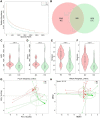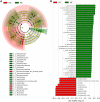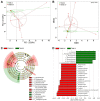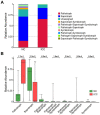Alterations of gut mycobiota profiles in intrahepatic cholangiocarcinoma
- PMID: 36687597
- PMCID: PMC9853418
- DOI: 10.3389/fmicb.2022.1090392
Alterations of gut mycobiota profiles in intrahepatic cholangiocarcinoma
Abstract
Objective: Intrahepatic cholangiocarcinoma (ICC) is a silent liver malignancy with an increasing incidence. Gut mycobiota plays a crucial role in benign liver diseases; however, its correlation with ICC remains elusive. This study aimed to elucidate fungal differences in patients with ICC compared to healthy controls.
Methods: The 40 fecal samples from 23 ICC patients and 17 healthy controls were collected and analyzed using ITS2 rDNA sequencing. Obtaining the OTUs and combining effective grouping, we carried out the biodiversity and composition of the fungi, as well as FUNGuild functional annotation.
Results: Our results revealed the presence of intestinal fungal dysbiosis with significant enrichment of opportunistic pathogenic fungi such as Candida and C. albicans, and significant depletion of the beneficial fungus Saccharomyces cerevisiae in ICC patients compared with healthy controls. Alpha-diversity analysis demonstrated that patients with ICC showed decreased fungal diversity compared to healthy controls. Beta diversity analysis indicated that the two groups exhibited significant segregated clustering. Besides, C. albicans was found to be significantly more abundant in the ICC patients with TNM stage III-IV than those with stage I-II. The FUNGuild functional classification predicted that pathotrophs were the most abundant taxon in the ICC group, well above their abundance in healthy controls.
Conclusion: This study indicates that dysbiosis of the fecal mycobiome might be involved in ICC development. Further research into gut fungi may contribute to new therapeutic options for ICC patients.
Keywords: Candida albicans; ITS2 rDNA sequencing; dysbiosis; gut mycobiome; intrahepatic cholangiocarcinoma.
Copyright © 2023 Zhang, Chen, Chai, Kuang, Deng and Wang.
Conflict of interest statement
The authors declare that the research was conducted in the absence of any commercial or financial relationships that could be construed as a potential conflict of interest.
Figures





Similar articles
-
Characterization of the intestinal fungal microbiome in patients with hepatocellular carcinoma.J Transl Med. 2023 Feb 15;21(1):126. doi: 10.1186/s12967-023-03940-y. J Transl Med. 2023. PMID: 36793057 Free PMC article.
-
Gut mycobiome dysbiosis and its impact on intestinal permeability in attention-deficit/hyperactivity disorder.J Child Psychol Psychiatry. 2023 Sep;64(9):1280-1291. doi: 10.1111/jcpp.13779. Epub 2023 Apr 5. J Child Psychol Psychiatry. 2023. PMID: 37016804
-
The gut mycobiome of the Human Microbiome Project healthy cohort.Microbiome. 2017 Nov 25;5(1):153. doi: 10.1186/s40168-017-0373-4. Microbiome. 2017. PMID: 29178920 Free PMC article.
-
Gut mycobiota changes in liver diseases: A systematic review.Med Mycol. 2023 Aug 2;61(8):myad071. doi: 10.1093/mmy/myad071. Med Mycol. 2023. PMID: 37463798
-
Fungi in Gastrointestinal Tracts of Human and Mice: from Community to Functions.Microb Ecol. 2018 May;75(4):821-829. doi: 10.1007/s00248-017-1105-9. Epub 2017 Nov 6. Microb Ecol. 2018. PMID: 29110065 Review.
Cited by
-
Exploring the effects of gut microbiota on cholangiocarcinoma progression by patient-derived organoids.J Transl Med. 2025 Jan 9;23(1):34. doi: 10.1186/s12967-024-06012-x. J Transl Med. 2025. PMID: 39789543 Free PMC article. Review.
-
Gut Microbiota in Diagnosis, Therapy and Prognosis of Cholangiocarcinoma and Gallbladder Carcinoma-A Scoping Review.Microorganisms. 2023 Sep 21;11(9):2363. doi: 10.3390/microorganisms11092363. Microorganisms. 2023. PMID: 37764207 Free PMC article.
-
Age and Tumor Stage Interplay in Intrahepatic Cholangiocarcinoma: Prognostic Factors, Mortality Trends, and Therapeutic Implications from a SEER-Based Analysis.Diseases. 2025 Jan 25;13(2):31. doi: 10.3390/diseases13020031. Diseases. 2025. PMID: 39997038 Free PMC article.
-
Causal roles of gut microbiota in cholangiocarcinoma etiology suggested by genetic study.World J Gastrointest Oncol. 2024 Apr 15;16(4):1319-1333. doi: 10.4251/wjgo.v16.i4.1319. World J Gastrointest Oncol. 2024. PMID: 38660662 Free PMC article.
-
Elucidating the causal association between gut microbiota and intrahepatic cholangiocarcinoma through Mendelian randomization analysis.Front Microbiol. 2023 Nov 14;14:1288525. doi: 10.3389/fmicb.2023.1288525. eCollection 2023. Front Microbiol. 2023. PMID: 38033576 Free PMC article.
References
-
- A NHN, B ZS, B STB (2016). FUNGuild: an open annotation tool for parsing fungal community datasets by ecological guild. Fungal Ecol. 20, 241–248. doi: 10.1016/j.funeco.2015.06.006 - DOI
LinkOut - more resources
Full Text Sources

